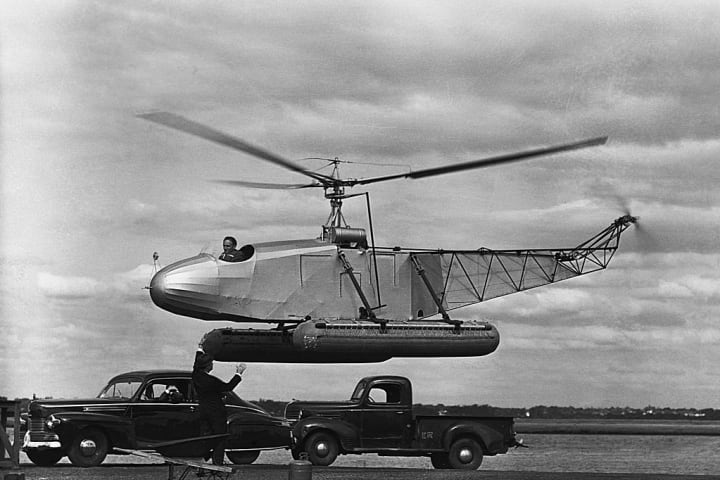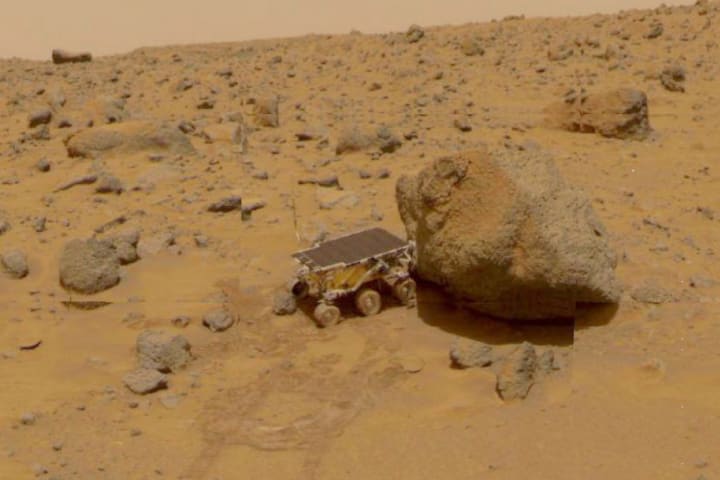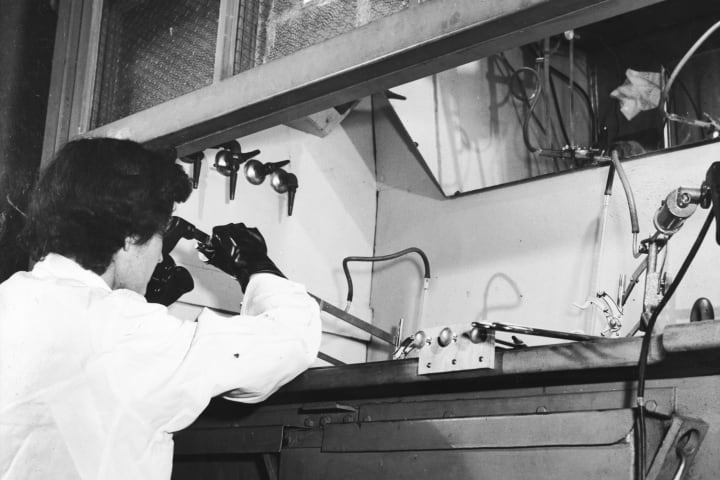11 Scientific Advancements Inspired by Sci-Fi Stories

Ideas can come from all sorts of places, and inspiration can hit in a flash—think of Archimedes supposedly yelling “Eureka! Eureka!” in the bath when he realized that irregular items could be accurately measured through water displacement. But sometimes, it’s fiction, not reality, that provides the spark of inspiration. There are sci-fi tales, for example, that have gone beyond predicting technological advancements to directly inspiring scientific progress, from robotics to rocketry and everything in between. Here are 11 advancements inspired by works of science fiction to read up on while we wait for teleportation beyond the quantum level.
Written under a pen name and published in 1911 by the Stratemeyer Syndicate (which also published the Nancy Drew and Hardy Boys novels), Tom Swift and His Electric Rifle sees the titular character invent a weapon that looks like an ordinary rifle but fires bolts of electricity. The book was a childhood favorite of Jack Cover and partly inspired the creation of his own electroshock weapon: The Taser.
Cover, an aerospace scientist, began developing the device in the late 1960s in response to the concern that sky marshals firing a gun on a plane would pierce the fuselage or hit critical machinery. He wanted the weapon to be non-lethal (though the end result is more accurately described as “less-lethal”), and inspiration struck when he read about a man who was briefly immobilized after walking into an electric fence. By 1974, Cover had created his own version of Tom Swift’s sci-fi weapon—and as a nod to Swift, he named the device TASER, an acronym of “Thomas A. Swift’s Electric Rifle.” (He added the A to make the word easier to pronounce.)

As a young boy, Igor Sikorsky read a Russian translation of Jules Verne’s 1886 book Robur the Conqueror, also known as The Clipper of the Clouds, and it fired his imagination. Sikorsky not only had Verne’s description of the helicopter, the Albatross, to stoke the flames of his passion, he also had illustrations by artist Leon Bennett, who worked from Verne’s own sketches of the flying machine.
Sikorsky tested his first helicopter design in 1909 but couldn’t get it into the air; following another failed attempt in 1910, he switched over to airplanes. Thirty years later, he returned to helicopters, now with decades of aviation experience to pull from. Sikorsky submitted a patent for his helicopter design in 1931, though other experimental helicopters were flown before his was tested—the first being Louis Bréguet’s Gyroplane Laboratoire in 1935 [PDF]. These early choppers used multiple main rotors, but it was Sikorsky’s design of one main rotor on the body and a smaller tail rotor to counteract torque that proved groundbreaking (or, rather, sky-breaking).
In 1939, Sikorsky successfully performed a tethered test flight of the VS-300, the prototype of the first practical helicopter—a momentous flight that lasted mere seconds. (An untethered flight was performed in 1940, after which hundreds more test flights were flown.) By 1942 he had created the first mass-produced helicopter, the XR-4, and his rotor configuration is still used for most helicopters to this day.
Without Arthur C. Clarke’s 1960s-era short story “Dial F for Frankenstein,” there might be no World Wide Web as we know it. The sci-fi story is about a global, interconnected telephone network that gains sentience—and it served as one of Tim Berners-Lee’s inspirations when he created the Web while working at CERN in the 1980s. In a 2002 Internet Society interview (above), Clarke acknowledged the impact his story had on Berners-Lee, declaring, “I guess I’m the godfather of the World Wide Web.” Thankfully, Berners-Lee’s invention hasn’t gained consciousness and taken over the world as in Clarke’s story … at least, not yet.
Tomotaka Takahashi is one of the leading scientists working on humanoid robots, and for him, it all started with Osamu Tezuka’s Astro Boy. The manga series, which initially ran from 1952 to 1968, follows the adventures of an android—the titular Astro Boy—created by Dr. Umataro Tenma. “When I was 4 or 5 years old, I read a comic book of Astro Boy and that was the beginning,” Takahashi said in an interview. He specifically loved “the description of how scientists build the robot,” which “really inspired me, to do robotics and be a robot scientist.”
The android has also directly influenced the design of Takahashi’s creations—especially in the case of Kirobo, a 13-inch tall robot companion that was built for astronaut Koichi Wakata while working aboard the International Space Station. Kirobo features the same color palette as Astro Boy, right down to the red boots, and is designed to look just as cute and friendly.
The father of rocketry, Robert H. Goddard, pinned his initial interest in making space travel a reality on reading 1898’s The War of the Worlds when he was 16. In 1926, he launched the first liquid-fueled rocket, a momentous event in the history of space flight. Six years later he sent a letter [PDF] to War of the Worlds author H.G. Wells, in which he declared that the novel “made a deep impression … I decided that what might conservatively be called ‘high altitude research’ was the most fascinating problem in existence. The spell did not break, and I took up physics,” adding, “how many more years I shall be able to work on the problem I do not know; I hope, as long as I live. There can be no thought of finishing, for ‘aiming at the stars,’ both literally and figuratively, is a problem to occupy generations.” The theoretical and engineering advancements Goddard achieved throughout his lifetime provided a crucial foundation for scientists working at the dawn of the Space Age.
Scientists haven’t figured out how to make humans invisible yet, but it seems as though they are on their way—and that’s partly thanks to Wells’s 1897 novel The Invisible Man, in which a scientist makes himself invisible by creating chemicals that alter his skin’s refractive index to match that of the surrounding environment.
Alon Gorodetsky, an associate professor of chemical and biomolecular engineering at UC Irvine, is one of the scientists working on human invisibility. Gorodetsky says he was “inspired by a lot of science fiction-type stuff that I used to love as a kid—those kinds of fantastic concepts that even H. G. Wells was thinking about 120 years ago.”
In a 2020 Nature Communications paper, Gorodetsky and a team of scientists outlined how they used a protein from the opalescent inshore squid, which—like many other cephalopods—can camouflage itself by changing color to match its environment, to turn human kidney cells almost completely transparent. Gorodetsky believes this is just the start; his goal is to “make human skin that can change its transparency, like squid skin.”

Physicist Peter H. Smith, professor emeritus at the Lunar and Planetary Laboratory of the University of Arizona, attributes his initial interest in extraterrestrial worlds to Ray Bradbury’s sci-fi stories, including those in The Martian Chronicles (1950) and The Illustrated Man (1951). In a foreword to the essay collection Orbiting Ray Bradbury’s Mars (2013), Smith wrote that “as a child, I could feel his arm around my shoulder leading me into alien landscapes never imagined.”
Smith set out to explore these alien landscapes. He designed cameras for the Sojourner Rover used during the Pathfinder mission that landed on Mars in 1997. Following the lead of astronauts exploring the habitability of Mars in some of Bradbury’s short stories, Smith also served as the principal investigator for the Phoenix mission, which in 2008 landed an uncrewed probe to investigate the presence of water on the Red Planet and its past and potential habitability.
Masamune Shirow’s Ghost in the Shell manga series, originally published between 1981 and 1991, features a technology called thermoptic camouflage, which renders its users near-invisible. Masahiko Inami, a professor at the University of Tokyo, read the manga while he was working on his Ph.D. and said it made him realize that, while “it may not be possible to make objects physically invisible, it may be possible from an engineering aspect to make them visually invisible by blending them into the surrounding scenery through three-dimensional images.”
Inami first presented his optical camouflage, which works by projecting real time three-dimensional images onto retroreflective material, in 1999. Although the technology isn’t up to sci-fi standards just yet, Inami described the practicality of the technology in 2020: Beyond its possible use as an invisibility cloak like in Ghost in the Shell, he believes that it could reduce blind spots in vehicles by making “car interiors such as pillars … transparent” and be used as “a tool to support medical diagnosis and surgeries.”
Inami isn’t the only scientist working on this kind of reflective camouflage: Susumu Tachi of the University of Tokyo has created a similar material, called “retro-reflective project” technology, or RPT; researchers at the University of California San Diego are working on material that will cloak drones, and scientists at the University of California Berkeley hope to use nanotechnology to disguise objects as big as planes.

In 1914’s The World Set Free, H.G. Wells predicted a city-destroying weapon, which he called an atomic bomb, that was small enough to be deployed from planes and “would continue to explode indefinitely.” His novel not only predicted the atomic bomb, it also inspired physicist Leo Szilard to help create it. Szilard read The World Set Free in 1932 and later said that it “made a very great impression on me, but I didn’t regard it as anything but fiction.” Still, the seed was planted.
The next year, Szilard—who fled Germany when Hitler came to power—was staying in London’s Bloomsbury neighborhood when he read in The Times newspaper that physicist Ernest Rutherford thought harnessing atomic energy was nonsense. “This sort of set me pondering as I was walking the streets of London,” he would later recall. During this walk, inspiration hit, and he theorized the nuclear chain reaction that would take Wells’s idea from fiction to reality. (Strangely enough, Wells also seems to have prophesied the exact year and location of this breakthrough: The author’s fictional scientist, Holsten, also cracked atomic energy in 1933 while living in Bloomsbury.)
Szilard went on to help create and work on the Manhattan Project, and in 1954, he credited Wells as the father of the atomic bomb [PDF]. The scientist once said that The World Set Free made clear to him “what the liberation of atomic energy on a large scale would mean.”
In 1867, Jules Verne attended the Exposition Universelle and saw a model of the Plongeur, the first submarine to be propelled by mechanical power—via a compressed-air engine—rather than human power. Two years later, the author began publishing Twenty Thousand Leagues Under the Sea as a serial in Magasin d’Éducation et de Récréation. The story featured an even more advanced underwater vessel called the Nautilus.
Simon Lake read Verne’s novel when he was 14 years old and was captivated by Captain Nemo’s Nautilus. In 1894, at the age of 27, he developed and launched the Argonaut Junior, the first submarine of many across his naval engineering career. His version of ballast tanks for stability and diving planes to better control submerging and surfacing—both of which are features of the Nautilus—contributed to advancements in submarine technology.

Published under the pseudonym Anson MacDonald, Robert Heinlein’s short story “Waldo” is about a scientist named Waldo Farthingwaite-Jones who invents a device to help him manage his degenerative muscle disease. His machine can perfectly mimic his hand movements, but with greater strength and from a distance. This device is essentially a remote manipulator, also known as a telefactor. Because of Heinlein’s story, some call the mechanism—which, according to Fundamentals of Robot Mechanics, “usher[ed] in the era of teleoperators”—a “waldo.”
Development of such devices occurred in numerous fields, including the nuclear industry. John Payne, a scientist at the General Electric Knolls Atomic Power Laboratory, and Raymond Goertz, an engineer at Argonne National Laboratory, led research teams, funded by the United States Atomic Energy Commission, that were tasked with developing remote manipulators to handle radioactive materials. In 1948, Payne submitted the patent for the first such device, just six years after the publication of “Waldo”; Goertz’s version was patented the following year. Today, waldos are also used in space, in surgical operating rooms, and by puppeteers.



